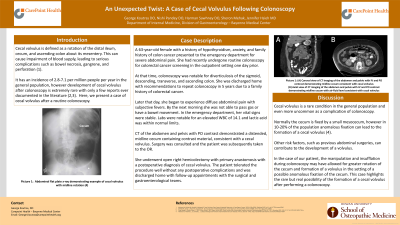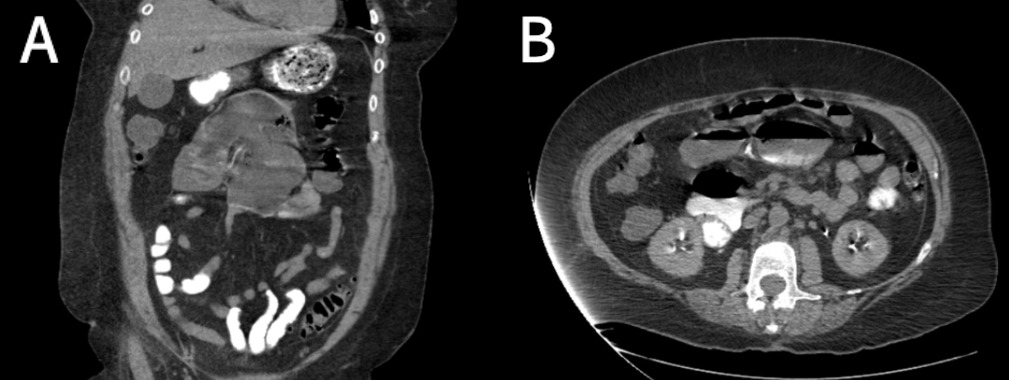Monday Poster Session
Category: General Endoscopy
P2008 - An Unexpected Twist: A Case of Cecal Volvulus Following Colonoscopy
Monday, October 23, 2023
10:30 AM - 4:15 PM PT
Location: Exhibit Hall

Has Audio

George Koutras, DO
Carepoint Health - Bayonne Medical Center
Bayonne, NJ
Presenting Author(s)
George Koutras, DO1, Nishi Pandey, DO1, Harman Sawhney, DO1, Sheron Mehak, 2, Jennifer Hsieh, MD3
1Carepoint Health - Bayonne Medical Center, Bayonne, NJ; 2Rowan-Virtua School of Osteopathic Medicine, Bayonne, NJ; 3Carepoint Medical Group, Hoboken, NJ
Introduction: Cecal volvulus is defined as a rotation of the distal ileum, cecum, and ascending colon about its mesentery. This can cause impairment of blood supply, leading to serious complications such as bowel necrosis, gangrene, and perforation. It has an incidence of 2.8-7.1 per million people per year in the general population, however development of a cecal volvulus after colonoscopy is extremely rare with only a few reports ever documented in the literature. Here, we present a case of a cecal volvulus after a routine colonoscopy.
Case Description/Methods: A 63-year-old female with a history of hypothyroidism, anxiety, and family history of colon cancer presented to the emergency department for severe abdominal pain. She had recently undergone routine colonoscopy for colorectal cancer screening in the outpatient setting one day prior. At that time, colonoscopy was notable for diverticulosis of the sigmoid, descending, transverse, and ascending colon. She was discharged home with recommendations to repeat colonoscopy in 5 years due to a family history of colorectal cancer. Later that day, she began to experience diffuse abdominal pain with subjective fevers. By the next morning she was not able to pass gas or have a bowel movement. In the emergency department, her vital signs were stable. Labs were notable for an elevated WBC of 14.1 and lactic acid was within normal limits. CT of the abdomen and pelvis with oral contrast demonstrated a distended, midline cecum containing contrast material, consistent with a cecal volvulus. Surgery was consulted and the patient was subsequently taken to the operating room. She underwent open right hemicolectomy with primary anastomosis with a postoperative diagnosis of cecal volvulus. The patient tolerated the procedure well without any postoperative complications and was discharged home with follow-up appointments with the surgical and gastroenterological teams.
Discussion: Cecal volvulus is a rare condition in the general population and even more uncommon as a complication of colonoscopy. Certain risk factors, such as previous abdominal surgeries, can contribute to the development of a volvulus. In the case of this patient who had no other risk factors, the manipulation and insufflation during colonoscopy may have allowed for greater rotation of the cecum and formation of a volvulus. This case highlights the rare but real possibility of the formation of a cecal volvulus after performing a colonoscopy.

Disclosures:
George Koutras, DO1, Nishi Pandey, DO1, Harman Sawhney, DO1, Sheron Mehak, 2, Jennifer Hsieh, MD3. P2008 - An Unexpected Twist: A Case of Cecal Volvulus Following Colonoscopy, ACG 2023 Annual Scientific Meeting Abstracts. Vancouver, BC, Canada: American College of Gastroenterology.
1Carepoint Health - Bayonne Medical Center, Bayonne, NJ; 2Rowan-Virtua School of Osteopathic Medicine, Bayonne, NJ; 3Carepoint Medical Group, Hoboken, NJ
Introduction: Cecal volvulus is defined as a rotation of the distal ileum, cecum, and ascending colon about its mesentery. This can cause impairment of blood supply, leading to serious complications such as bowel necrosis, gangrene, and perforation. It has an incidence of 2.8-7.1 per million people per year in the general population, however development of a cecal volvulus after colonoscopy is extremely rare with only a few reports ever documented in the literature. Here, we present a case of a cecal volvulus after a routine colonoscopy.
Case Description/Methods: A 63-year-old female with a history of hypothyroidism, anxiety, and family history of colon cancer presented to the emergency department for severe abdominal pain. She had recently undergone routine colonoscopy for colorectal cancer screening in the outpatient setting one day prior. At that time, colonoscopy was notable for diverticulosis of the sigmoid, descending, transverse, and ascending colon. She was discharged home with recommendations to repeat colonoscopy in 5 years due to a family history of colorectal cancer. Later that day, she began to experience diffuse abdominal pain with subjective fevers. By the next morning she was not able to pass gas or have a bowel movement. In the emergency department, her vital signs were stable. Labs were notable for an elevated WBC of 14.1 and lactic acid was within normal limits. CT of the abdomen and pelvis with oral contrast demonstrated a distended, midline cecum containing contrast material, consistent with a cecal volvulus. Surgery was consulted and the patient was subsequently taken to the operating room. She underwent open right hemicolectomy with primary anastomosis with a postoperative diagnosis of cecal volvulus. The patient tolerated the procedure well without any postoperative complications and was discharged home with follow-up appointments with the surgical and gastroenterological teams.
Discussion: Cecal volvulus is a rare condition in the general population and even more uncommon as a complication of colonoscopy. Certain risk factors, such as previous abdominal surgeries, can contribute to the development of a volvulus. In the case of this patient who had no other risk factors, the manipulation and insufflation during colonoscopy may have allowed for greater rotation of the cecum and formation of a volvulus. This case highlights the rare but real possibility of the formation of a cecal volvulus after performing a colonoscopy.

Figure: (A) Coronal view of CT imaging of the abdomen and pelvis with IV and oral contrast demonstrating midline cecum consistent with cecal volvulus. (B) Axial view of CT imaging of the abdomen and pelvis with IV and oral contrast demonstrating midline cecum with air-fluid level consistent with cecal volvulus.
Disclosures:
George Koutras indicated no relevant financial relationships.
Nishi Pandey indicated no relevant financial relationships.
Harman Sawhney indicated no relevant financial relationships.
Sheron Mehak indicated no relevant financial relationships.
Jennifer Hsieh indicated no relevant financial relationships.
George Koutras, DO1, Nishi Pandey, DO1, Harman Sawhney, DO1, Sheron Mehak, 2, Jennifer Hsieh, MD3. P2008 - An Unexpected Twist: A Case of Cecal Volvulus Following Colonoscopy, ACG 2023 Annual Scientific Meeting Abstracts. Vancouver, BC, Canada: American College of Gastroenterology.
